Part Twenty Four Why study social media, chiasm, the Declaration of Independence, and Constitution, and inspiration?
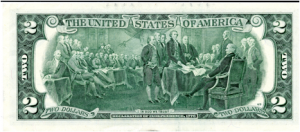 Presentation of the Declaration of Independence in 1776, painting by John Trumbull, seated John Hancock, standing in front of the table, tallest Thomas Jefferson, far left John Adams, Livingston, and Sherman, far right Benjamin Franklin. On the reverse of the Two Dollars currency, series 2013, In God We Trust banner. The Continental Congress seated at Philadelphia Pennsylvania.
Presentation of the Declaration of Independence in 1776, painting by John Trumbull, seated John Hancock, standing in front of the table, tallest Thomas Jefferson, far left John Adams, Livingston, and Sherman, far right Benjamin Franklin. On the reverse of the Two Dollars currency, series 2013, In God We Trust banner. The Continental Congress seated at Philadelphia Pennsylvania.
This is Part Twenty Four and Twenty Five of a series showing how inflation, postage, history, economics, religion, and education are combined into one great whole. Postage rates demonstrate how money has changed value.
Part Twenty Four Why study social media, chiasm, the Declaration of Independence, and Constitution, as they affect inspiration.
Inspired from on High: the Declaration of Independence and Constitution
To the Latter-Day Saint, patriotic celebrations in the United States of Amrica should have a special meaning. For 2018, CBS news reported ‘’A Facebook algorithm categorized parts of the Declaration of Independence as hate speech and took down excerpts of it ahead of the Fourth of July.’’ ‘’Facebook sent a notice that one of those parts “goes against our standards on hate speech.” Facebook said in a statement to CBS News, “The post was removed by mistake and restored as soon as we looked into it. We process millions of reports each week, and sometimes we get things wrong.”
Well, at least, the Declaration made the news, even if from censorship on astonishing social media.
We have been reminded that the signing of the Declaration of Independence was no casual event, because it was inspired from on high. On July 4, 1776, at the Pennsylvania statehouse, later renamed Independence Hall by the Marquis de Lafayette, principles were established which are as stirring today as they were two centuries ago. It was fitting to bring the Congress to the City of Brotherly love for this action. 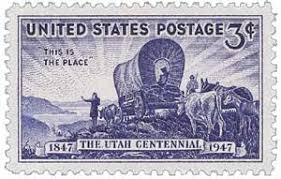 1947 This is the Place The Utah Centennial 1847 1947. United States Postage 3 c. blue.
1947 This is the Place The Utah Centennial 1847 1947. United States Postage 3 c. blue.
Brigham Young, in his Discourses (p. 359), said that the Almighty “moved upon the signers of the Declaration of Independence, . . . in the same way as he moved upon ancient and modern Prophets, each being inspired to accomplish the particular work he was called to perform.” He specifically named the signers who were inspired as prophets. “In this view we consider that the men in the revolution were inspired by the Almighty,” and “for this cause were Adams, Franklin, [and] Jefferson,” inspired to their deeds. President Young described the form of this inspiration. “It was the voice of the Lord inspiring all those worthy men.”
The Declaration of Independence and Constitution are examples of divine inspiration. President Marion G. Romney once noted that no one can be justified in rejecting the teachings revealed by the Lord, on the basis that he “does not know that they are true, because everything the Lord does or says has within itself the evidence of its own authenticity, and every person is divinely endowed with the means to discover that evidence.” (Church news, April 10, 1976, p . 20) What is evidence of their authenticity? 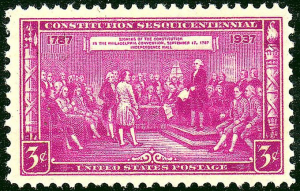 1787-1937 Constitution Sesquicentennial 3c United States Postage. Signing of the Constitution in the Philadelphia Convention, September 17, 1787, Independence Hall
1787-1937 Constitution Sesquicentennial 3c United States Postage. Signing of the Constitution in the Philadelphia Convention, September 17, 1787, Independence Hall
The Declaration of Independence, because of its significance, has perhaps been among the most widely imitated documents in the history of mankind. In the two and a quarter centuries since it was drafted, hundreds of millions of people in the world have seen it. It has served as a form and model for dozens of governments that have been established since its adoption.
Upon reading the Declaration, no one could reject the clear intent of the humble feelings of gratitude displayed by the delegates of the Continental Congress when they said “And for the support of this Declaration with a firm reliance on the protection of divine Providence, we mutually pledge to each other our Lives, our Fortunes and our sacred Honor.” 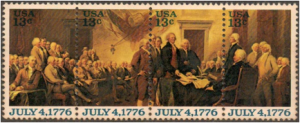 1976 Bicentennial adoption of the Declaration of Independence July 4, 1776, 13 c USA Seated John Hancock, Thomas Jefferson standing with hand on the Declaration. In Congress.
1976 Bicentennial adoption of the Declaration of Independence July 4, 1776, 13 c USA Seated John Hancock, Thomas Jefferson standing with hand on the Declaration. In Congress.
Many have the beginning of the Declaration memorized: “When in the Course of human events,”
Has there ever been any other document of such broad circulation? Yet, we have cause to be alert. In 1975, as chairman of the Church Bicentennial Committee, L. Tom Perry attended a national meeting with religious leaders to assist in planning America’s celebration. They failed to adopt a statement of gratitude For the Lord’s hand in directing the formation of the government of the United States of America. “They reasoned such a declaration would be offensive to the atheist.” As well they might, because the earlier Declaration was certainly offensive to the king. Elder Perry stated that he was shocked by the outcome. One religious leader even said, “I find no evidence in my studies of God’s hand directing the affairs of mankind in any age.” (Ensign magazine, Nov. 1975, p. 86). 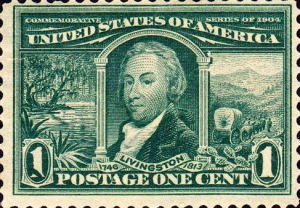 Robert Livingston 1746-18113, United States of America Postage One Cent, Commemorative Series of 1903. Member of Drafting Committee for the Declaration of Independence.
Robert Livingston 1746-18113, United States of America Postage One Cent, Commemorative Series of 1903. Member of Drafting Committee for the Declaration of Independence.
Ezra Taft Benson also warned that as the nation has become self- sufficient, the new religion of “secularism” has arisen – the belief that God is no longer, “or never was,” a part of American history. (Church news, April 3, 1976, p. 7). Historical “humanism” should not be surprising. The prophet Joseph Smith stated, in reference to the gifts of the Holy Ghost, that “the world can in general know nothing about them.” And, as he quoted Paul, “no man knows the things of God but by the Spirit of God.” (Teachings of the prophet Joseph Smith compiled by Joseph Fielding Smith, Deseret Book Company, 1974, p. 245-247).
Who could have imagined, 200 years ago, that some Americans would fail even to acknowledge the Lord’s hand in our Independence, much less offer gratitude for his protection? None of those patriots would have imagined such a circumstance, but the Lord anticipated this in the last days. The words given to Moses seem appropriate. “And in a day when the children of men shall esteem my words as naught,” the Lord would bring them “again among the children of men – among as many as shall believe.” (Moses 1:41). 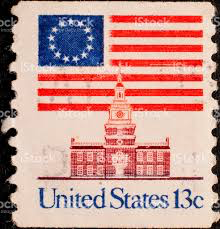 United States 13C Independence Hall, Philadelphia Pennsylvania with 13 stars and stripes flag.
United States 13C Independence Hall, Philadelphia Pennsylvania with 13 stars and stripes flag.
The Lord has prepared for such a day with the Declaration of Independence, even as he prepared for the Book of Mormon. “And it shall come to pass that the Lord God shall bring forth unto you the words of a book, and they shall be the words of them which have slumbered. And the day cometh that the words of the book which were sealed shall be read upon the house tops; and they shall be read by the power of Christ; and all things shall be revealed unto the children of men which ever have been among the children of men, and which ever will be even unto the end of the earth.” (2 Nephi 27:6, II). The Lord prepared for the day when the reprobates would deny the power of God? “Yea, wo be unto him that hearkeneth unto the precepts of men, and denieth the power of God, and the gift of the Holy Ghost.” (2 Nephi 28:26).
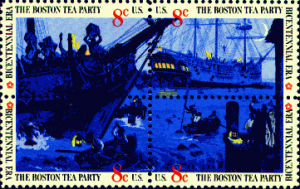 To review briefly, the War for Independence developed in a land which had been settled by the English for more than 160 years. The French and Indian War was over in 1763, but other grievances began to be pronounced as Britain’s Parliament pressed direct taxes on the colonies and tightened custom controls.
To review briefly, the War for Independence developed in a land which had been settled by the English for more than 160 years. The French and Indian War was over in 1763, but other grievances began to be pronounced as Britain’s Parliament pressed direct taxes on the colonies and tightened custom controls.
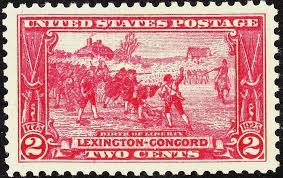 The Boston Massacre had occurred in 1770, the Boston Tea Party in 1773 and by 1775 with the battles of Lexington and Concord,
The Boston Massacre had occurred in 1770, the Boston Tea Party in 1773 and by 1775 with the battles of Lexington and Concord,
Lexington and Concord Two Cents Birth of Liberty.
and then Bunker Hill, the Continental Congress resolved to take up arms and appointed Washington as Commander in Chief of the forces. 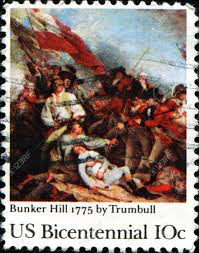 Bunker Hill 1775 by Trumbull US Bicentennial 10c. 1975
Bunker Hill 1775 by Trumbull US Bicentennial 10c. 1975
The Second Continental Congress adopted the Olive Branch Petition, a final attempt to achieve an understanding with the Crown. This was refused and during the winter of 1775-76, as the war intensified, all chance for accommodation vanished. By the time the Continental Congress adopted the Declaration in July, 1776, both sides had armies in the field continuously, so the War of Independence had been underway for more than a year.
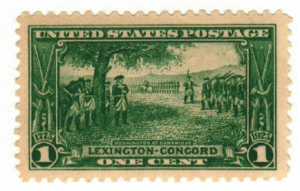 1775-1923 One Cent Lexington Concord United States Postage. Washington at Cambridge.
1775-1923 One Cent Lexington Concord United States Postage. Washington at Cambridge.
The Second Continental Congress represented all Thirteen Colonies for the first time as Georgia had sent its delegates in the fall of 1775. Congress disclaimed allegiance to Parliament, created a navy, and appointed a committee of foreign affairs.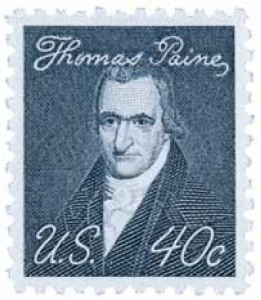 In January of 1776, a pamphlet called “Common Sense” was published, and this has been credited as a turning point in the consideration of independence. The pamphlet was widely read. It created furor. Authored anonymously by the Thomas Paine, Common Sense showed an intimate familiarity with the Bible. Thomas Paine U.S. 40c Blue 1968
In January of 1776, a pamphlet called “Common Sense” was published, and this has been credited as a turning point in the consideration of independence. The pamphlet was widely read. It created furor. Authored anonymously by the Thomas Paine, Common Sense showed an intimate familiarity with the Bible. Thomas Paine U.S. 40c Blue 1968
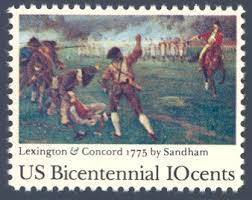 US Bi-centennial 10cents Lexington 7 Concord 1775 by Sandham.
US Bi-centennial 10cents Lexington 7 Concord 1775 by Sandham.
In May, 1776, Congress authorized the colonies to form permanent governments. On June 7, 1776, Richard Henry Lee proposed, as the leader of the Virginia delegation and as authorized by Virginia, and moved that the colonies declare their independence, create articles of confederation between themselves, and form foreign alliances. (The Writings of Thomas Jefferson, ed. Andrew Lipscomb, Washington, D.C.: The Thomas Jefferson Memorial Association, 1903, 1: 17-18.) Lee’s resolution concluded “That these United Colonies are, and of right ought to be, free and independent States, that they are absolved from all allegiance to the British Crown, and that all political connection between them and the State of Great Britain is, and ought to be, totally dissolved.” After some debate on the motion, on June 11th, Congress decided to postpone the final vote until July 1st, and appoint a committee to draw a suitable declaration of independence, 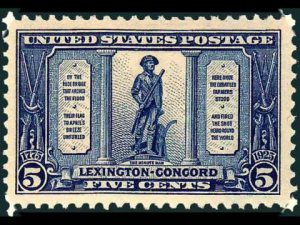 in the meantime, if the motion was approved. Lexington Concord Five Cents. United States Postage. Minute Man. By the Rude Bridge that arched the flood, Their Flag to April’s Breeze Unfurled, Here Once the embattled farmers stood, and fired the shot heard round the world. By Ralph Waldo Emerson. 1775-1925
in the meantime, if the motion was approved. Lexington Concord Five Cents. United States Postage. Minute Man. By the Rude Bridge that arched the flood, Their Flag to April’s Breeze Unfurled, Here Once the embattled farmers stood, and fired the shot heard round the world. By Ralph Waldo Emerson. 1775-1925
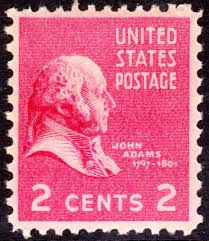 John Adams 1797-1801 2 cents United States Postage Pink.
John Adams 1797-1801 2 cents United States Postage Pink.
Three of the drafting committee’s five members, John Adams, age 40 from Massachusetts and later President, Doctor Benjamin Franklin, age 70 from Pennsylvania, a former Post Master General and discoverer of electricity, and Thomas Jefferson, age 33 from Virginia and later Vice President and President, favored independence. Roger Sherman, age 55 and later Mayor of New Haven Connecticut, had recently backed the independence movement, and Robert R. Livingston, age 29 and later chancellor of New York State who administered George Washington’s oath of office for the Presidency, opposed Lee’s resolution. (Dumas Malone, Jefferson the Virginian, Boston: Little, Brown and Company, 1948, pp. 219-220. 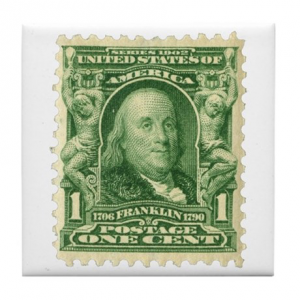 Locations and offices from Webster’s Biographical Dictionary, Massachusetts, 1951.) Franklin 1706-1790 Postage One Cent. Series 1902 United States of America, green.
Locations and offices from Webster’s Biographical Dictionary, Massachusetts, 1951.) Franklin 1706-1790 Postage One Cent. Series 1902 United States of America, green.
John Adams, more than a generation later, wrote of the reasons Thomas Jefferson, a new member of Congress, was chosen to be on this committee. “Mr. Jefferson came into Congress in June 1775, and brought with him a reputation for literature, science, and a happy talent at composition. Writings of his were handed about, remarkable for the peculiar felicity of expression. Though a silent member in Congress, he was so prompt, frank, explicit and decisive, upon committees…that he seized on my heart.” (As quoted by Timothy Pickering, Colonel Pickering’s Observations Introductory to Reading the Declaration of Independence, Salem, Mass.: Warwick Palfray, 1823, p. 8.) Not only was Jefferson called to the committee, but wrote the Declaration himself. John Adams explains: “The Committee had several meetings, in which were proposed the Articles of which the Declaration was to consist, and minutes made of them. The Committee than appointed Mr. Jefferson and me, to draw them up in form, and cloath them in a proper Dress. The Sub Committee met, and considered the minutes…when Mr. Jefferson desired me to take them to my Lodgings and make the Draught. This I declined and gave several reasons for declining…I had a great Opinion of the Elegance of his pen and none at all of my own. 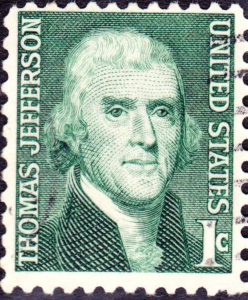 I therefore insisted that no hesitation should be made on his part. He accordingly took the Minutes and in a day or two produced to me his Draught…in substance at least it was reported to Congress.” (Diary and Autobiography of John Adams, ed. L.H. Butterfield, Cambridge, Mass.: Harvard University Press, 1961, 3: 336-337.) 1C Thomas Jefferson United States 1968 Green.
I therefore insisted that no hesitation should be made on his part. He accordingly took the Minutes and in a day or two produced to me his Draught…in substance at least it was reported to Congress.” (Diary and Autobiography of John Adams, ed. L.H. Butterfield, Cambridge, Mass.: Harvard University Press, 1961, 3: 336-337.) 1C Thomas Jefferson United States 1968 Green.
A day or two! As amazing as Adams’ report may seem, they agree with Jefferson’s memory. “The committee of five met…they unanimously pressed on myself alone to undertake the draught. I consented; I drew it; but before I reported it to the committee, I communicated it separately to Dr. Franklin and Mr. Adams, requesting their corrections…Their alterations were two or three only, and merely verbal. I then wrote a fair copy, reported it to the committee, and from them unaltered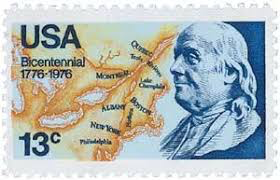 , to Congress.” (Writings of Jefferson, 15: 461.) The Committee presented Jefferson’s draft to the House of Congress on June 28. (Ibid., 1:26) Benjamin Franklin USA Bicentennial 1776-1976 13C
, to Congress.” (Writings of Jefferson, 15: 461.) The Committee presented Jefferson’s draft to the House of Congress on June 28. (Ibid., 1:26) Benjamin Franklin USA Bicentennial 1776-1976 13C
From these words it appears that Jefferson composed the Declaration in a day or two. Not only did he accomplish this feat, but he also reports, “I know only that I turned to neither book nor pamphlet while writing it.” (Ibid., 15: 462)
At the time Lee had introduced his resolution, seven of the colonies – New Hampshire, Rhode Island, Massachusetts, Connecticut, Virginia, North Carolina, and Georgia – favored independence. New York, New Jersey, Pennsylvania, Maryland, Delaware, and South Carolina were either opposed or undecided. Throughout June, efforts were made by the Patriots in these provinces to gain control of the assemblies. The drafting committee submitted Jefferson’s “peculiar felicity of expression” as Adams put it, on June 28th , 1776. July 2nd was the day of decision. Congress debated and voted. Although both the committee and Congress made changes, the statement remained distinct. Although the delegates had anticipated an almost unanimous vote for independence, only nine colonies supported; Pennsylvania and South Carolina opposed; 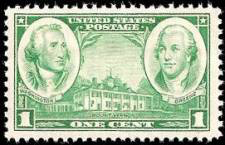 New York abstained; and the two delegates from Delaware were deadlocked. Technically the resolution had carried but the solidarity desirable for such a vital decision was absent. 1936 One Cent Mount Vernon. Washington and Green.
New York abstained; and the two delegates from Delaware were deadlocked. Technically the resolution had carried but the solidarity desirable for such a vital decision was absent. 1936 One Cent Mount Vernon. Washington and Green.
Edward Rutledge of South Carolina, suggested that the vote be retaken the next day. That day was to be one of the most dramatic in the history of the world. John Adams of Massachusetts exerted an overwhelming influence. South Carolina reversed its position. Two conservatives among the seven Pennsylvanians, Robert Morris and John Dickinson, though unwilling to support independence, cooperated by being absent. The remaining delegates voted 3 to 2 in favor of it. To further the excitement, Caesar Rodney, Delaware’s third delegate, galloped up to the Philadelphia State house after a harrowing 80 mile night ride from Dover through a thunderstorm to break the Delaware tie. Home on a military assignment, the evening before, Rodney received an urgent plea from Thomas McKean to race to Philadelphia. In the final vote, 12 colonies approved Lee’s resolution, New York abstained. Congress declared the resolution to be in effect. (Historical background from Signers of the Declaration, R.G. Ferris, editor, United States Department of the Interior, National Park Service, 1973, U.S.G.P.O.).
Several ministers were in the Congress, including Lyman Hall, William Hooper, Robert Treat Paine,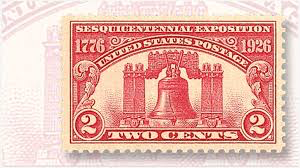 and John Witherspoon, descendant of John Knox and Stewart Lord Ochiltree. There is every reason to believe that all of the other participants were intimately familiar with the Bible. 1926 Sesquicentennial Exposition 1776-1926 United States Postage two cents Liberty Bell.
and John Witherspoon, descendant of John Knox and Stewart Lord Ochiltree. There is every reason to believe that all of the other participants were intimately familiar with the Bible. 1926 Sesquicentennial Exposition 1776-1926 United States Postage two cents Liberty Bell.
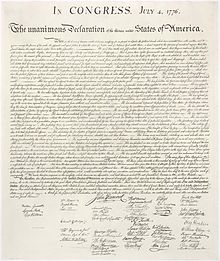 “A peculiar felicity of expression” indeed! It should not be unexpected. The Lord has said, “For thou art an holy people unto the Lord thy God, and the Lord hath chosen thee to be a peculiar people unto himself, above all the nations that are upon the earth.” (Deut. 14:2). And again Paul said, that our Saviour Jesus Christ “gave himself for us, then he might redeem us from all iniquity, and purify unto himself a peculiar people, zealous of good works.” (Titus 2:14). They were indeed, peculiar people.
“A peculiar felicity of expression” indeed! It should not be unexpected. The Lord has said, “For thou art an holy people unto the Lord thy God, and the Lord hath chosen thee to be a peculiar people unto himself, above all the nations that are upon the earth.” (Deut. 14:2). And again Paul said, that our Saviour Jesus Christ “gave himself for us, then he might redeem us from all iniquity, and purify unto himself a peculiar people, zealous of good works.” (Titus 2:14). They were indeed, peculiar people.
A similar “peculiar felicity of expression” is found in the Book of Mormon in a poetic literary style, called introverted parallelism, or chiasm, a word derived from the Greek letter Chi, “X,” to imply a crossing. In 3 Nephi 11:32 we read: “I bear record of the Father, and the Father beareth record of me.” Which may be keyed as follows: ABCC’B’A’:
Key #1 – Book of Mormon 3 Nephi 11:3
A I
B bear record of the
C Father, and the
C’ Father
B’ beareth record of
A’ me,
John Welch, a scholar of the scriptures, wrote that “a careful look at these verses reveals something that at first glance is not altogether obvious; namely, that the words occur in a peculiar sequence.” Everything is repeated twice, and in the repetition everything is given back to front or in a reverse order. (“Chiasmus in the Book of Mormon or the Book of Mormon does it again” by John W. Welch, Feb. 1972, The New Era, p. 6). 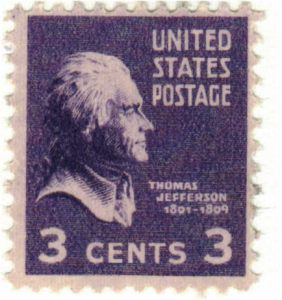 1938 Thomas Jefferson 1801-1809 3 cents United States Postage Purple
1938 Thomas Jefferson 1801-1809 3 cents United States Postage Purple
In the Declaration of Independence at verse 121, (verse lines refer to The United States Code annotated edition of the Declaration) we read “Enemies in War, in Peace Friends.” This would be keyed as follows: ABB’A’:
Key #2 – Declaration of Independence, verse 121
A Enemies
B in War,
B’ in Peace
A’ Friends
Welch noted it “is important for us to notice that chiasmus is not just a simple repetition; it also involves an intensification or an aspect of completion in the second half.” Compare, for example, more powerful ideas of Declaration, verse 121: the word “Enemies” is contrasted with “friends, ” and “war” is contrasted with “peace. ”
“Quite consistently, therefore, a shift can be seen to occur at the center of the chiasm so that the bigger, more powerful, or more intense ideas will appear on the second half of the chiastic passages.” Another chiasmus appears at Declaration verse 6 which refers to the “Laws of Nature and of Nature’s God.”
Disclaimer: The author of each article published on this web site owns his or her own words. The opinions, beliefs and viewpoints expressed by the various authors and forum participants on this site do not necessarily reflect the opinions, beliefs and viewpoints of Utah Standard News or official policies of the USN and may actually reflect positions that USN actively opposes. No claim in public domain or fair use. © John Choate, with research by Mark Choate, 1976,1988,2003 Copyright, Proprietary
Utah Standard News depends on the support of readers like you.
Good Journalism requires time, expertise, passion and money. We know you appreciate the coverage here. Please help us to continue as an alternative news website by becoming a subscriber or making a donation. To learn more about our subscription options or make a donation, click here.
To Advertise on UtahStandardNews.com, please contact us at: ed@utahstandardnews.com.


Comments - No Responses to “Part Twenty Four Why study social media, chiasm, the Declaration of Independence, and Constitution, and inspiration?”
Sure is empty down here...